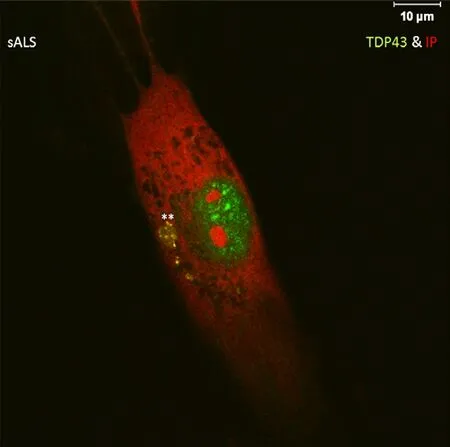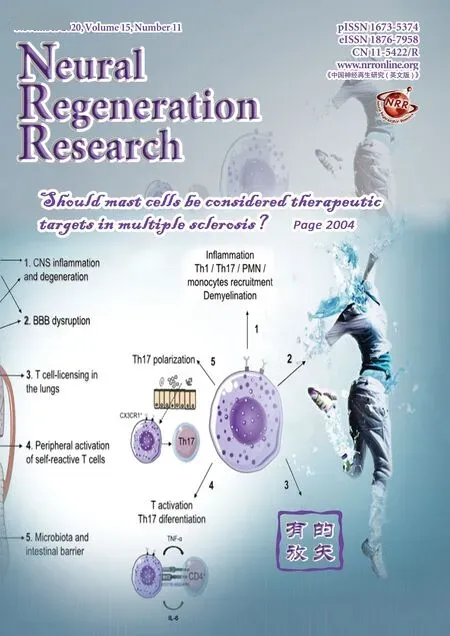Dermic-derived fibroblasts for the study of amyotrophic lateral sclerosis
Among neurodegenerative diseases, amyotrophic lateral sclerosis (ALS) is the most frequent one involving motor neurons(MNs). ALS incidence varies throughout the world ranging from 0.7 to 4 cases per 100,000 habitants and year (Riancho et al., 2016). This disease, which currently lacks an effective therapy, is characterized by a variable combination of upper and lower MN degeneration, leading to progressive muscle wasting which usually results in a terminal respiratory failure within 3 years after symptom onset (Zufiria et al., 2016). A small proportion of ALS cases show familial aggregation. These are related to mutations in specific causative genes (Cr9ORF72,TARDBP,FUS,SOD1and others) which directly determine disease onset in carriers. By contrast, more than 90 percent of cases are considered to be sporadic, in which generally unknown environmental and internal factors interact with genetic predisposing factors finally leading to disease (Riancho et al., 2018). From a histopathological point of view, ALS is characterized by MN damage and loss. MNs from ALS sporadic and most of familial patients exhibit prominent transactive response DNA-binding protein 43 (TDP-43) cytoplasmic aggregates which are considered as the “pathological hallmark” of the disease, excepting those related toSOD1andFUSmutations (Zufiria et al.,2016). TDP-43 is a DNA/RNA binding protein encoded by theTARDBPgene that controls the expression of many different genes.
Although during the last decade knowledge about ALS has notably expanded and many potential molecular mechanisms have been proposed, the pathogenesis of ALS has not been fully elucidated yet. In this vein, there are still crucial unsolved issues,such as, for example, what is the precise trigger of the disease and whether ALS is a multisystem disease or by contrary it only affects the central nervous system. As an unfortunate consequence of the absence of definitive answers to those questions,we do not have an effective therapy to offer to ALS patients (Zufiria et al., 2016).
The deficient models of the disease:The lack of an effective treatment for ALS patients should prompt scientific community to be on the search for new therapies for the disease. Importantly, this is not a problem of not having worked on it, but a lack of success of the investigations carried out so far. Similarly to the situation of several neurodegenerative diseases, during the last decades, tens of drugs have been tried out in ALS patients with disappointing results. Somewhat surprisingly, many of them had highly promising results in animal models but then failed when tested in humans (Ittner et al., 2015). This should make us reflect on important issues, such as if we are using appropriate disease animal models, or whether experimental designs reflect an approach holistic enough to recapitulate the pathogenesis of the disease in humans (Ittner et al., 2015; Zufiria et al., 2016).
The most commonly used ALS murine model, the SOD1 mice, has been reported to be a suboptimal model due to the absence of TDP-43 cytoplasmic aggregates in spinal MNs or to a disproportionate degeneration of lower MNs in comparison to upper MNs. In recent years, other animal and cellular models have been developed (Lutz, 2018). Among them, MN differentiation from induced pluripotential stem cells and the direct MN re-programming seem of particular interest (Picher-Martel et al., 2016). However, these techniques are expensive,time consuming and also exhibit intrinsic technical difficulties mostly related to the intrinsic variability of reprogrammed cells(Picher-Martel et al., 2016). Within this scenario, the pursuit of simpler and patient-derived models that might be used as an individualized biological avatar for both the investigation of pathogenic features and initial drug screening targeted to an individual case appear particularly interesting.
Fibroblasts as a potential easy-manageable ALS model in a“multi-systemic disease”:The absence of feasible and clinically-relevant models to explore disease biomarkers and potential therapies, motivated us to evaluate dermis-derived fibroblasts as a potential simple, viable, rapid and cost-efficient cellular model of ALS. Previously, other authors worked with skin fibroblasts of ALS patients, specifically with patients with familial ALS, with partially discordant or uncertain results (Sabatelli et al., 2015)(Figure 1). In our study, primary fibroblasts were obtained from a 4-mm diameter human punch skin biopsy and cultured with Dulbecco’s modified eagle medium/20% fetal bovine serum as previously published. Following this simple protocol, cells were available for experiments within a few weeks. In this manner, we were able to corroborate previous results that pointed out that skin-derived fibroblasts from ALS patients show a reduced proliferation rate (Riancho et al., 2020). Very interestingly, we documented that ALS fibroblasts exhibited some degree of TDP-43 proteinopathy.Specifically, we observed that ALS fibroblasts had a partial loss of nuclear TDP-43, as well as an increased tendency for cytoplasmic TDP43 aggregation (Riancho et al., 2020). We consider these results of particular interest since they might be recapitulating the“key ALS pathogenetic hallmark” in MNs, with a double mechanism of both TDP-43 loss of function - gain of function. In other words, the abnormalities seen in these accessible cells may be the same as those taking place in the inaccessible MNs. Of note, one group previously reported that primary fibroblasts did not recapitulate such alterations (Codron et al., 2018). In our opinion, these discordances may be due to several culture-related factors, such as cell confluence degree or growing medium conditions, which might induce cellular stress and consequently make cells more vulnerable to TDP-43 misslocalization.
Besides the TDP-43 proteinopathy, we demonstrated that dermic ALS derived fibroblasts exhibited deficient DNA damage reparation mechanisms (Riancho et al., 2020). Defective DNA damage response has been suggested to be an important pathogenic mechanism in several neurodegenerative diseases. Along this concept, neurons, as post-mitotic cells, would progressively accumulate DNA damage until they reach a threshold, from which the neuron would not be able to function normally and eventually would degenerate. In this framework, subjects with neurodegenerative diseases, including ALS, would exhibit higher susceptibility to accumulate DNA damage foci (Madabhushi et al., 2014).

Figure 1 A representative confocal image of double fluorescent labelling for TDP-43 (green) and propidium iodide (red) in an ALS-derived fibroblast.
Regarding ALS, several genetic forms of the disease, includingCr9ORF72orFUS, had been associated with defective DNA damage response. Nevertheless, it had not been previously communicated in sporadic cases. Hence, our results provide new evidences supporting the role of DNA damage response pathways in the pathogenesis of ALS (Riancho et al., 2020). Intriguingly,abnormal responses seem to be extensive to non-neuronal cellular populations.
In addition to fibroblasts, although less studied, other peripheral and accessible cell populations such as peripheral blood mononuclear cells have also been assessed in ALS patients. In their studies, De Marco et al. (2017) reported a pathological TDP-43 accumulation in circulating lymphomocytes of both ALS patients with familial TDP-43 mutations and sporadic ALS cases. Regarding mature blood circulating monocytes, the same pathological TDP-43 deposit was described in several subgroups of ALS patients.
We believe that these results encompass important consequences from a double point of view. Firstly, and in addition to murine and more sophisticated/complex models of the disease,simple and easily obtainable cellular models as dermic primary fibroblasts emerge as a useful tool to study TDP-43 proteinopathy, an ALS hallmark, which might be valuable for investigating pathogenic hypothesis as well as for the screening of new drugs in a cellular model directly relevant to human disease.
Secondly, the involvement of non-neuronal populations support the conception that ALS might not only be a central nervous system disorder but also a systemic disease affecting peripheral neural and non-neural tissues (Zufiria et al., 2016).In line with this conception, several investigations have demonstrated the involvement of non-neural structures in ALS. In addition to the recently described TDP-43 deposition in cutaneous, somatic and autonomic nerves of ALS patients, a pathological increased TDP-43 expression was stated in the skin of patients with ALS (Suzuki et al., 2010). As a further support of the value of these observations, there is a correlation between protein expression and the duration of the disease (Suzuki et al.,2010).
Moreover, it has been hypothesized that ALS progression might be enforced by subjacent metabolic abnormalities, including both fatty acid and carbohydrate metabolism (Zufiria et al.,2016). This concept lies on diverse clinical and analytical studies documenting an unexpected increased ALS incidence among subjects with low body mass index, professional sportsmen, and subjects undergoing very restrictive diets (Riancho et al., 2018).Furthermore, certain metabolic abnormalities, mainly related to the lipid profile, have also been reported in ALS patients.
Concluding remarks:There is an urgent need to make new therapies available for ALS patients. ALS seems to be not circumscribed to the central nervous system. Instead, it may be more widespread, a systemic disorder involving non-neuronal cellular populations. Upon this concept, dermic fibroblasts emerge as a new, rapid, economic and manageable cellular model that recapitulates, at least partially, the pathogenesis of the disease seeming to be a promising tool for both pathogenic studies, identification of new therapeutic targets and early drug screening.
Javier Riancho*, Sara Arozamena, Adolfo López de Munaín
Service of Neurology, Hospital Sierrallana-IDIVAL, Torrelavega,Spain (Riancho J, Arozamena S)
Department of Medicine and Psychiatry, University of Cantabria,Santander, Spain (Riancho J)
一旁钱总也随声附和:“哦,叶总你都这么说了,八成是这里面有故事啊。看来今天是来对了,又可以听听你的故事会了。”一边说着,钱总一边摆出一副要听评书的样子。
Centro de Investigación en Red de Enfermedades Neurodegenerativas, Instituto Carlos III, Madrid, Spain(Riancho J, López de Munaín A)
Neurosciences Area, Biodonostia Research Institute; Service of Neurology, Hospital Universitario Donostia; Department of Neurosciences, School of Medicine and Nursery, University of the Basque Country, San Sebastián, Spain (López de Munaín A)
*Correspondence to:Javier Riancho, MD, PhD,javier.riancho86@gmail.com.
orcid:0000-0001-7929-1055 (Javier Riancho)
Received:January 27, 2020
Peer review started:February 15, 2020
Published online:May 11, 2020
doi:10.4103/1673-5374.282257
Copyright license agreement:The Copyright License Agreement has been signed by all authors before publication.
Plagiarism check:Checked twice by iThenticate.
Peer review:Externally peer reviewed.
Open access statement:This is an open access journal, and articles are distributed under the terms of the Creative Commons Attribution-NonCommercial-ShareAlike 4.0 License, which allows others to remix, tweak, and build upon the work non-commercially, as long as appropriate credit is given and the new creations are licensed under the identical terms.
- 中国神经再生研究(英文版)的其它文章
- Muscovite nanoparticles mitigate neuropathic pain by modulating the inflammatory response and neuroglial activation in the spinal cord
- Knocking down TRPM2 expression reduces cell injury and NLRP3 inflammasome activation in PC12 cells subjected to oxygen-glucose deprivation
- Neuroprotective mechanisms of ε-viniferin in a rotenone-induced cell model of Parkinson’s disease:significance of SIRT3-mediated FOXO3 deacetylation
- Amyloid-beta peptide neurotoxicity in human neuronal cells is associated with modulation of insulin-like growth factor transport, lysosomal machinery and extracellular matrix receptor interactions
- MicroRNA regulatory pattern in spinal cord ischemiareperfusion injury
- Sequencing analysis of matrix metalloproteinase 7-induced genetic changes in Schwann cells

